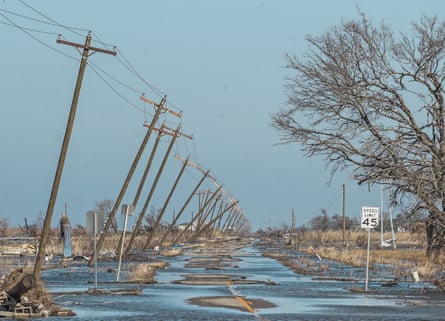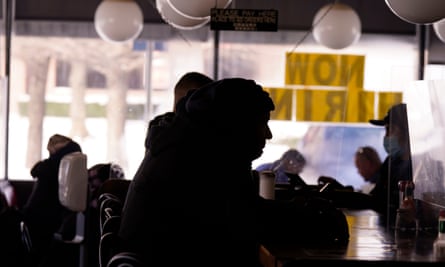In the days leading up to Hurricane Ian in 2022, Jeffrey Perdomo and his parents resisted increasingly stern calls from officials to evacuate their mobile home in Kissimmee, Florida.
“We don’t have much and we wanted to stay on top of our things,” said the 25-year-old, who works as a restaurant host at Disney’s Animal Kingdom, just outside Orlando. The family’s trailer was old and uninsured; Perdomo wanted to be around to address any damage as soon as it happened. “If it ended up flooding, we would have very little recourse. We would become effectively homeless.”
Miraculously, the mobile home made it through the category 5 hurricane, one of the deadliest in the state’s history. But well after calm winds and blue skies returned, the family remained without power. For seven days, Perdomo and his elderly parents endured sweltering temperatures while the food in their refrigerator rotted (cooking was impossible without the electric stovetop), forcing them to rely on a food bank.
It was the longest the family – originally from the Dominican Republic and no stranger to hurricanes – had gone without power. “It was really, really tough,” Perdomo said.
But not everyone in the Orlando area had it so tough. A slew of recent studies has shown that power outages occur in low-income and minority communities – like the ones the Perdomos live in – more often and last longer.
Last year researchers at Georgia Tech found that communities with lower socioeconomic ratings (a score based on the Center for Disease Control and Prevention’s (CDC) social vulnerability index that considers census data like race, income, education and car access) waited an average of almost three hours longer to have their power restored after a storm. More specifically, a one-decile drop in socioeconomic status was associated with a 6.1% longer outage. (Osceola county, where Perdomo lives, has a SVI score of .86, what the CDC considers a high level of vulnerability.)
“The common perception that more economically vulnerable communities experience longer power outages is consistent with the data,” said Scott Ganz, lead author of the paper and now a professor at Georgetown University. He said that the researchers analyzed outage data across nine south-eastern states during eight major hurricanes between 2017 and 2020 and compared it against SVI scores of the 15 million customers who lost power during that time period.
“This is a very large geographic area, and a lot of storms over a large number of utilities. These are not ad hoc patterns or specific to a particular context,” he said.

The study, published in Nature Communications, joins a growing body of research indicating that power outages are more prevalent and prolonged in low-income and historically disadvantaged communities. Last spring, a study from the Columbia Mailman School of Public Health analyzed three years of outage data and found that regions with high SVI scores and pervasive poverty – among them Louisiana, Arkansas, central Alabama and northern Michigan – experienced more frequent outages. These regions also endured more blackouts that lasted eight hours or longer, outages considered “medically significant” since they outlast the backup battery life in many medical devices. Another study identified “a significant disparity in the extent and duration of power outages experienced by low-income and minority groups” during a severe ice storm in Texas during the winter of 2021.
None of these studies nails down a specific reason why low-income communities and communities of color spend more time in the dark, but theories range from ageing infrastructure in poorer communities to inherent biases in storm-response procedures. For instance, after a storm restoration crews typically prioritize critical infrastructure such as healthcare facilities and commercial centers, which are often located in wealthier areas. Ganz and other researchers said utilities should reconsider post-storm restoration efforts, putting poorer neighborhoods near the top of the list.
“I think it’s increasingly the case that utilities have the data available in order to be able to tailor their response a little more surgically,” Ganz said. “That might mean recovery for the average consumer takes longer, but maybe there are some tradeoffs we’re willing to take as a society to ensure very vulnerable communities don’t experience especially long outages.”
By not prioritizing vulnerable populations, write the authors of a 2017 study that found Native American communities experience longer outages, “utilities are arguably not meeting their mandate to serve the public interest”.
That’s because lengthy outages can be catastrophic for low-income populations, who are less likely to evacuate during a major storm and more likely to struggle in its aftermath, whether it’s replacing a refrigerator full of spoiled food or recovering from temperature-related illness.
According to the US Department of Energy (DoE), since 2011 the average annual number of weather-related power outages has increased by nearly 80%. Experts believe the number and length of power outages will continue to increase as the climate crisis worsens and severe weather stresses an ageing and already strained US electrical grid.
But researchers said identifying communities most at risk during outages is difficult, since utility companies rarely share detailed statistics about when and where they happen and how long they last.
“They’re extremely hesitant to provide that. It’s something they have, but they aren’t willing to share it publicly,” said Dr Kelly Stevens, a professor of public administration at University of Central Florida (UCF). “I think there’s concern about showing some of those disparities.” In late 2022, the White House called on utilities to provide standardized, real-time outage numbers. As of July 2023, only 4% of all electric utility companies had complied.
In addition to withholding information that could help governments prepare for outages, utilities often push back against strategies that might prevent them in the first place, by opposing the development of microgrids – energy systems that can operate independently of the larger electrical grid, sometimes by relying on solar or battery storage – and community solar programs.

In the meantime, some public utilities are taking advantage of a DoE funding program to develop microgrids, while cities all over the country are investing in so-called resilience hubs, retrofitting churches, schools and community centers to support vulnerable populations before, during and after a storm. These facilities are often supported by solar power and backup battery storage and provide everything from a place to charge electronic devices to sessions with a grief counselor.
In Baltimore, 18 resilience hubs are scattered throughout the city’s low- and middle-income neighborhoods, where residents can gather during storms or deadly heatwaves to store their temperature-sensitive medicine, collect first aid equipment, or simply sit and talk. In Houston, officials are planning a network of 16 “Lily Pads”, resilience hubs on high ground to serve as safe refuge during flood events.
And back in central Florida, the city of Orlando is using a HUD community development block grant to upgrade six neighborhood centers “in intentionally chosen areas”, said Mike Hess, the city’s director of sustainability. “We looked at things like income, internet access and energy burden, or how much a person’s income is spent on energy costs … to make sure we’re helping the people who need that help the most.”
The city is also partnering with UCF to design mobile resilience hubs to be deployed after severe weather events to communities not in walking distance to a brick-and-mortar hub. Stevens, who leads the mobile hubs project, which is funded by the DoE and the National Science Foundation, said the team just finished gathering feedback from the community about where and what they’d like to see in a mobile hub.
“People wrote lots of notes indicating concerns about power outages. That it’s hard to stay cool, hard to charge their phone using only their car,” she said.
Last year, Perdomo took part in a UCF focus group about communities that could benefit from solar-plus-storage facilities. As participants shared their post-hurricane experiences, Perdomo realized his family’s week without power was not the norm.
“Most people lost power for two days, maybe four days at the maximum,” he said, though residents of Orlando’s Pine Hills neighborhood – a predominantly Black community – reported going a week and a half without electricity. On the other end of the spectrum was a participant from an affluent area who described a neighborhood solar cooperative. “It was much easier for them to endure the aftereffects of the hurricane than it was for us,” Perdomo said.
Jeffrey Perdomo said that in addition to practical things like ice and water, resilience hubs should provide relief for the mental impact of severe weather, too. “The stress that you go through, it takes a toll emotionally,” he said. “Those spaces could have something as simple as a corner to play chess in to get your mind off things. To get your energy off negative emotions.”
"low" - Google News
February 09, 2024 at 12:01AM
https://ift.tt/a6SRGrc
‘It takes a toll’: US low-income and communities of color endure longer power outages - The Guardian US
"low" - Google News
https://ift.tt/JCxIT7e
Bagikan Berita Ini














0 Response to "‘It takes a toll’: US low-income and communities of color endure longer power outages - The Guardian US"
Post a Comment